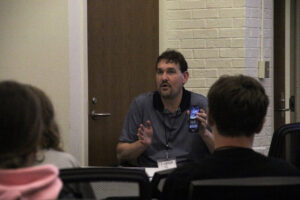How to get inspired for your next story
By Reagan Bell
East Mecklenburg High ‘24

The newspaper staff of First Flight High School often looks to its community for good story ideas.
For example, adviser Steve Hanf said, a local battered women’s shelter pitched a story about the shelter’s services during sexual assault awareness month, because sexual assault is an issue that affects high school students.
“My EICs were like yes you know, that would be great for us to cover, and so we had a whole package of stories about the shelter,” Hanf said.
Reaching out to your community is one way that journalists can avoid writer’s block, and being unable to brainstorm a story idea. It becomes difficult when story ideas feel repetitive, dry and not relevant enough to write. Here are tips that students and advisers at the North Carolina Scholastic Media Institute (NCSMI) suggested for brainstorming story ideas.
Trying new brainstorming methods
Introduce new ways to expand the brainstorming process that your staff typically uses. Adviser Bill Allen of the newspaper staff for East Mecklenburg High recommends a thought process called greenlighting.
“It’s not just a simple brainstorming,” Allen said. “Anyone can share any idea, even how crazy it may be, for a story, and the idea is that we don’t say no initially to think a little bit outside the box.”
Not every idea becomes a story, but the process creates a welcoming space where students can bring up unusual or controversial topics that sometimes get published.
Think about the newspaper’s audience
Hanf, the First Flight adviser, encourages taking audience into consideration to ensure the newspaper provides information students and teachers care about. “There’s all these different elements of news, like timeliness and human interest but ultimately, who cares?” Hanf said.
Regan Huntsman, Watauga High School ‘24, also said this was something to think about. “Our journalism class is diverse. We have a lot of athletes but also more artistic people,” Huntsman said. “So we put our heads together and try to think of things that a lot of the school population would like.”
Listening to anyone, anywhere
Finding new topics can be inspired by listening to what others have to say, whether it’s going around asking questions to see if anyone has an interesting story to tell or overhearing others’ conversations. Everyone has a story.
“I tried to ask people that I know to ask their friends, and I just tried to ask different people what they would be interested in hearing about,” said Lily Porter, Asheville Christian Academy ‘24. “I look at stuff in the past and stuff that people have cared more about.”
Consider things you overhear in class as potential stories – though they must be confirmed through reporting.
Read and be more aware of what’s happening in the world
Reading and listening to the news around you helps you brainstorm better story ideas.
“I love the Washington Post app, that’s my go to news app,” Hanf said. “There’s enough free journalism out there. If you’re interested in a topic and you want to read some good journalism, I think that’s the big thing. When you’re reading stuff like that, it’s just going to make you a better writer.”
